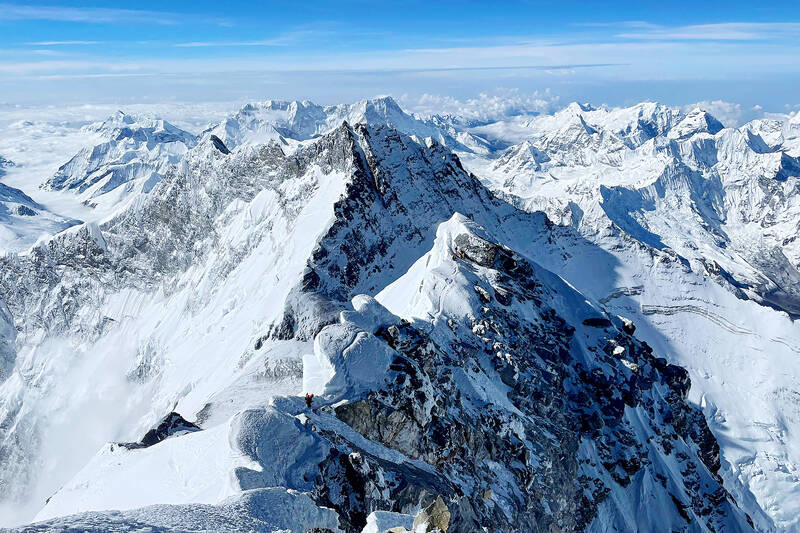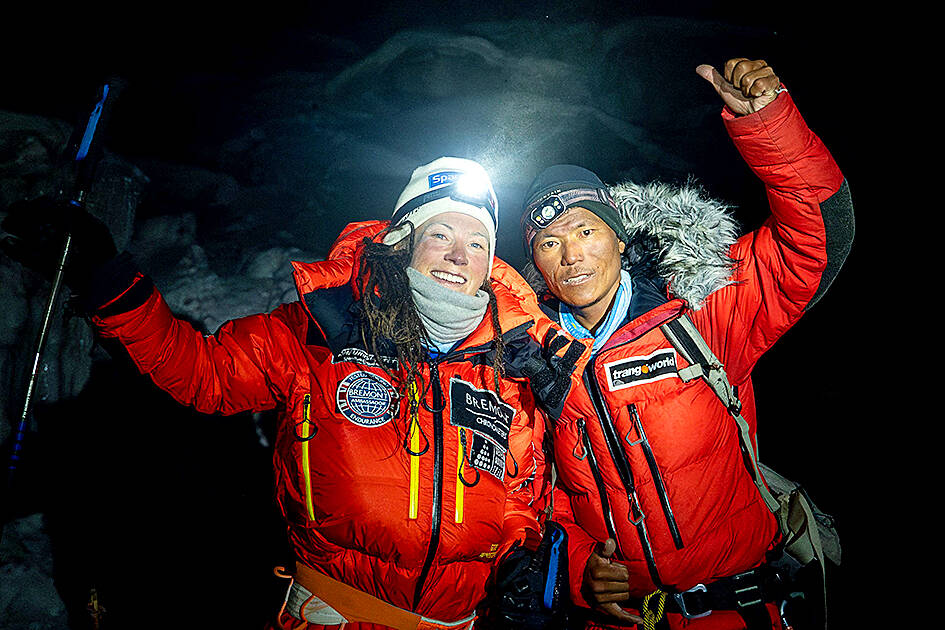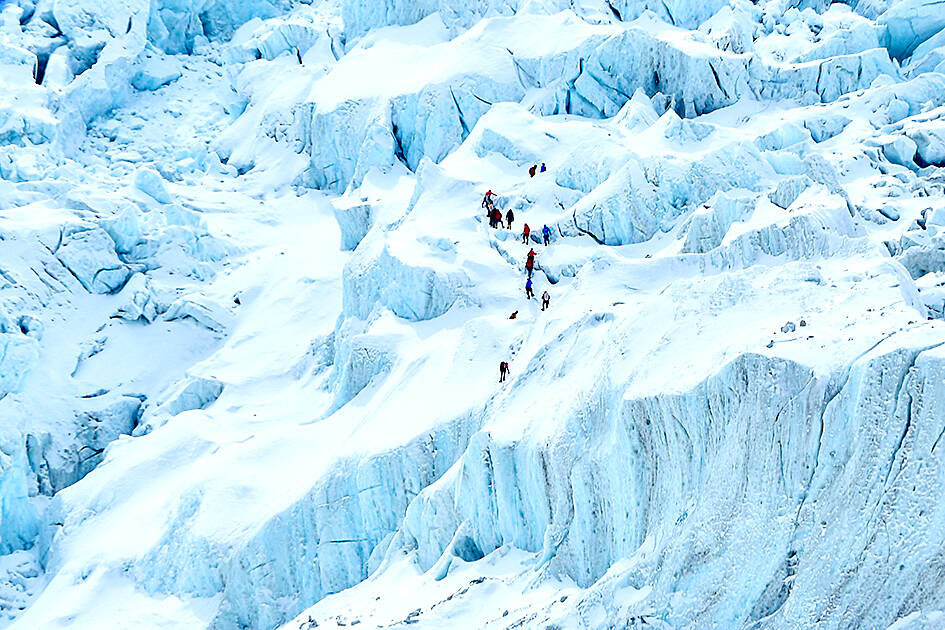A record number of climbers are gathered in Tibet to complete mountaineering’s pinnacle achievement, summiting the world’s tallest 14 peaks.
Only about 50 climbers have climbed all mountain peaks above 8,000 meters, a feat that took most years, or even decades, to complete.
About 20 are vying for the record books this month, some spurred by a blockbuster Netflix documentary giving the endeavor a wider profile.

Photo: AFP
Technological advancements have made the feat easier to accomplish.
“We are growing as a community, and we are representing mountaineering all over the world,” said Pakistani climber Shehroze Kashif, 22.
“I think that’s great... they are completing their dream, as I am.”

Photo: AFP
It took Italian climber Reinhold Messner 16 years from his initial summit to become the first person in the world considered to have climbed all 14 peaks in 1986.
But most of the climbers assembled in the Chinese Himalayas at the base camp of Mount Shisha Pangma only began their attempts within the past few years.
They have already summited the 13 other highest peaks, located in the Himalayan and Karakoram ranges, straddling Nepal, Pakistan, Tibet and India.

Photo: AFP
Many have been waiting to scale the 8,027-meter-high Tibetan peak since last year, when China closed the mountain to climbers after two American women and their Nepali guides were killed in an avalanche.
‘MOUNTAINS ATTRACT THEM’
The aspirants are a mix of seasoned veterans and rising stars.

Photo: AFP
Teenage Nepali climber Nima Rinji Sherpa, 18, aims to be the youngest to climb all 14.
Several hope to be the first from their respective countries to accomplish the feat.
Advances in mountaineering technology, weather forecasting and logistical support have made this once-inaccessible goal more achievable — particularly for those who can afford it.
Mingma Sherpa of Seven Summit Treks, Nepal’s biggest mountaineering expedition company, said that climbers could expect to pay up to US$700,000 for full support teams.
But he said the hefty price tag had not dissuaded a growing number of people from pursuing the endeavor.
“They climb one or two, and then the mountains attract them,” he said. “Soon they might decide to climb them all.”
Teams of support crews and helicopters for rapid transportation between base camps have allowed climbers to tackle multiple mountains in a single season.
“It is clear that the pioneers back then, they did much more difficult, dangerous and exceptional ascents,” said German mountaineering chronicler Eberhard Jurgalski.
“Now it is possible to do them within three months. The logistics are so world-class now.”
British-Nepali climber Nirmal Purja famously completed the 14 peaks in just over six months in 2019, shattering the previous record of seven years.
His efforts were chronicled in a Netflix documentary, inspiring a new wave of athletes to try and eclipse his speed run.
Norwegian climber Kristin Harila and her Nepali guide Tenjen Lama Sherpa — the latter who died attempting to summit Shisha Pangma last year — now hold the record.
They climbed the giant mountains in 92 days, ending in July last year. The pair also reached the “true summits” of all the mountains, which many previous climbers had missed.
This month, at least six have already completed the feat after summiting Shisha Pangma, including the first Japanese, Pakistani and female American climbers.
They also included Nirmal Purja again, who this time said he was climbing all 14 without supplementary oxygen.
‘ANOTHER CHALLENGE’
The trend towards speed has not always been welcomed by the mountaineering fraternity. Veteran climbers have criticized Purja and Harila for using helicopters, pre-prepared routes and support teams.
Dawa Yangzum Sherpa, who is aiming to become the first woman from Nepal to summit all 14 peaks, said the style of ascent dictated how much it was valued by other alpinists.
“Some... don’t have the capacity to climb without support,” she said.
But Russian climber Alina Pekova, also attempting the Tibetan summit to finish her 14-peak climb, said that speed ascents were an endurance test.
“If you can climb it a fast way, why not try?” she said. “That’s another challenge.”

In Taiwan’s politics the party chair is an extremely influential position. Typically this person is the presumed presidential candidate or serving president. In the last presidential election, two of the three candidates were also leaders of their party. Only one party chair race had been planned for this year, but with the Jan. 1 resignation by the currently indicted Ko Wen-je (柯文哲) of the Taiwan People’s Party (TPP) two parties are now in play. If a challenger to acting Chairman Huang Kuo-chang (黃國昌) appears we will examine that race in more depth. Currently their election is set for Feb. 15. EXTREMELY

Jan. 20 to Jan. 26 Taipei was in a jubilant, patriotic mood on the morning of Jan. 25, 1954. Flags hung outside shops and residences, people chanted anti-communist slogans and rousing music blared from loudspeakers. The occasion was the arrival of about 14,000 Chinese prisoners from the Korean War, who had elected to head to Taiwan instead of being repatriated to China. The majority landed in Keelung over three days and were paraded through the capital to great fanfare. Air Force planes dropped colorful flyers, one of which read, “You’re back, you’re finally back. You finally overcame the evil communist bandits and

Last week saw the appearance of another odious screed full of lies from the People’s Republic of China (PRC) Ambassador to Australia, Xiao Qian (肖千), in the Financial Review, a major Australian paper. Xiao’s piece was presented without challenge or caveat. His “Seven truths on why Taiwan always will be China’s” presented a “greatest hits” of the litany of PRC falsehoods. This includes: Taiwan’s indigenous peoples were descended from the people of China 30,000 years ago; a “Chinese” imperial government administrated Taiwan in the 14th century; Koxinga, also known as Cheng Cheng-kung (鄭成功), “recovered” Taiwan for China; the Qing owned

They increasingly own everything from access to space to how we get news on Earth and now outgoing President Joe Biden warns America’s new breed of Donald Trump-allied oligarchs could gobble up US democracy itself. Biden used his farewell speech to the nation to deliver a shockingly dark message: that a nation which has always revered its entrepreneurs may now be at their mercy. “An oligarchy is taking shape in America of extreme wealth, power and influence that literally threatens our entire democracy, our basic rights and freedoms,” Biden said. He named no names, but his targets were clear: men like Elon Musk